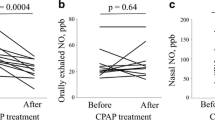Abstract
Purpose
In obstructive sleep apnea–hypopnea syndrome (OSAS), airway collapses and vibrations cause local and systemic inflammatory response and oxidative stress (OS). Our objective was to determine the presence of OS in the airway of patients with OSAS compared with controls without OSAS and determine its relation to treatment with CPAP and other clinical variables.
Method
We performed a prospective observational case–control study with repeated measures. We recruited consecutive patients with SAHS diagnosed using complete polysomnography, and a parallel control group. We collected a sample of exhaled breath condensate (EBC) prior to nasal continuous positive airway pressure (CPAP) treatment and again after 4 months. The marker of OS used was 8-isoprostane (8-IPN). The variables analyzed were age, sex, anthropometric variables, apnea–hypopnea index (AHI), snoring, oxygenation, and polysomnographic variables.
Results
The study included 20 patients and 10 controls. In cases, the initial value of 8-IPN was 6.8 (1.9), and after nasal CPAP, it was 5.3 (1.2) pg/ml (p = 0.02). In controls, the value of 8-IPN was 5.6 (1.1) pg/ml (p = 0.04 compared to initial values). 8-IPN showed significant correlation with snoring, AHI, BMI, nocturnal desaturation index, and non-REM sleep. On multivariate analysis, only snoring was a significant predictor of 8-IPN.
Conclusions
Snoring, and not OSAS severity, could be the phenomenon underlying the presence of local OS measured in the airway of patients with OSAS.

Similar content being viewed by others
References
Montesi SB, Bajwa EK, Malhotra A (2012) Biomarkers of sleep apnea. Chest 142(1):239–245
Karamanlı H, Özol D, Ugur KS et al (2012) Influence of CPAP treatment on airway and systemic inflammation in OSAS patients. Sleep Breath 18(2):251–256
Carpagnano GE, Kharitonov SA, Resta O et al (2003) 8-Isoprostane, a marker of oxidative stress, is increased in exhaled breath condensate of patients with obstructive sleep apnea after night and is reduced by continuous positive airway pressure therapy. Chest 124(4):1386–1392
Antonopoulou S, Loukides S, Papatheodorou G et al (2008) Airway inflammation in obstructive sleep apnea: is leptin the missing link? Respir Med 102(10):1399–1405
Li Y, Chongsuvivatwong V, Geater A et al (2008) Are biomarker levels a good follow-up tool for evaluating obstructive sleep apnea syndrome treatments? Respiration 76(3):317–323
Berry RB, Budhiraja R, Gottlieb DJ, American Academy of Sleep Medicine et al (2012) Rules for scoring respiratory events in sleep: update of the 2007 AASM manual for the scoring of sleep and associated events. Deliberations of the sleep apnea definitions task force of the American Academy of Sleep Medicine. J Clin Sleep Med 8(5):597–619. doi:10.5664/jcsm.2172
Lee SA, Amis TC, Byth K et al (2008) Heavy snoring as a cause of carotid artery atherosclerosis. Sleep 31(9):1207–1213
Rapoport DM (2014) Snoring- obnoxious (but medically innocent) noise or wakeup call for sleep medicine? Sleep Med Rev 18:451–452
Stuck BA, Dreher A, Heiser C et al (2015) Diagnosis and treatment of snoring in adults-S2k guideline of the German Society of Otorhinolaryngology, Head and Neck Surgery. Sleep Breath 19(1):135–148
Deary V, Ellis JG, Wilson JA et al (2014) Simple snoring: not quite so simple after all? Sleep Med Rev 18(6):453–462
Salepci B, Fidan A, Ketenci SC et al (2015) The effect of obstructive sleep apnea syndrome and snoring severity to intima-media thickening of carotid artery. Sleep Breath 19(1):239–246
Horváth I, Hunt J, Barnes PJ et al (2005) Exhaled breath condensate: methodological recommendations and unresolved questions. Eur Respir J 26(3):523–548
Acknowledgments
This study was funded by the Asturian Respiratory Society (ASTURPAR) with a research grant for the determination of 8-isoprostane.
Author information
Authors and Affiliations
Corresponding author
Ethics declarations
Conflict of Interest
None.
Ethical Approval
The study was approved by the Clinical Research Ethics Committee of our hospital.
Informed Consent
Informed consent was obtained from all individual participants included in the study.
Rights and permissions
About this article
Cite this article
Fernandez Alvarez, R., Rubinos Cuadrado, G., Alonso Arias, R. et al. Snoring as a Determinant Factor of Oxidative Stress in the Airway of Patients with Obstructive Sleep Apnea. Lung 194, 469–473 (2016). https://doi.org/10.1007/s00408-016-9869-0
Received:
Accepted:
Published:
Issue Date:
DOI: https://doi.org/10.1007/s00408-016-9869-0




